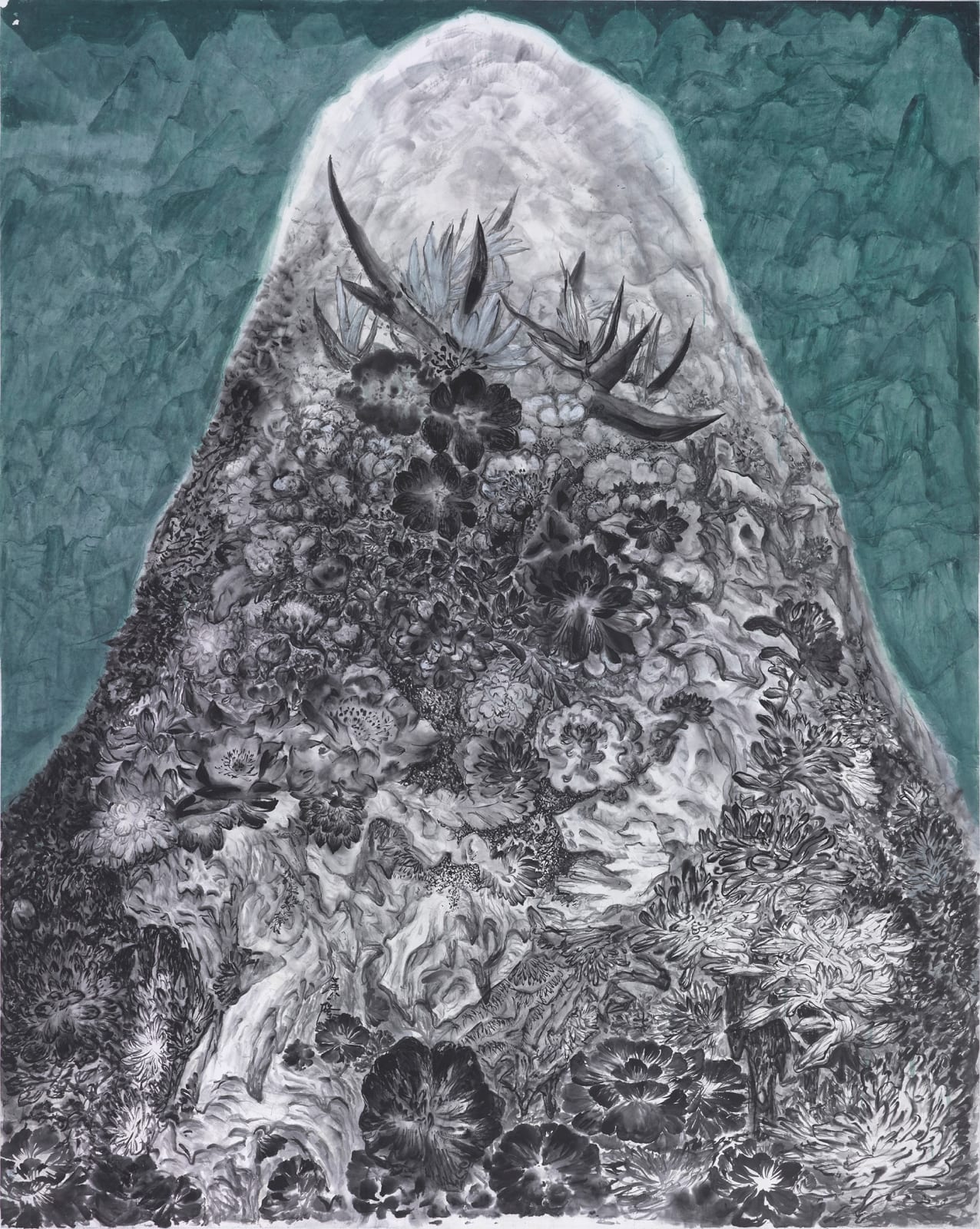Peng Kanglong 彭康隆
Landscape Pulses 山水脈搏, 2022
Ink and color on paper 紙本水墨設色
184 x 147 cm
Copyright The Artist
In Landscape Pulses, Peng Kanglong revisits his experiment from 2008 but invests it with a renewed vigor and boldness. As an ink monochrome against a color monochrome background, Landscape Pulses...
In Landscape Pulses, Peng Kanglong revisits his experiment from 2008 but invests it with a renewed vigor and boldness. As an ink monochrome against a color monochrome background, Landscape Pulses provides Peng Kanglong an opportunity to explore the tonal and textural possibilities of pure ink. Compared to Flowerist Mountain which employed a fairly restricted and dilute range of ink tones, Peng Kanglong here favors saturated inks and stark contrasts in ink tone and paper. The result is visually bolder and stronger—and noticeably less well-mannered.
Starting from the base of his triangular mountain form, Peng Kanglong paints boneless hibiscus and double-outline chrysanthemums in a dazzling variety of brush lines, ink tones, and patterns of untouched white. As your eye wanders from bloom to bloom, you soon realize he never paints the same bloom the same way twice. Starting in the lower left and curving up and to the right, Peng Kanglong adds a textured rock surface. Above this rock structure, he then adds peonies, roses, and hibiscus in a range of single and double flower forms rendered in variegated brush modes and ink tones. Compared to Flowerist Mountain from 2008, Peng Kanglong here uses untouched white and graded ink tones to visually convey a sense of form through light and shade—a method popularized by Renaissance and Baroque figure painters called chiaroscuro. As a result, his mountain form appears far more solid and stable, even as each individual element asserts its independent presence more emphatically. The floral assemblage is crowned with what looks like the thick spires of an agave and the mountain form completed by a bare, treeless alpine zone.
Behind his singular, ink flower-mountain, Peng Kanglong finishes the composition with a verdant expanse of 10,000 more mountains stretching for 10,000 miles.
在《山水脉搏》中,彭康隆重温了2008年的构图,并为其注入了新的活力和大胆的尝试。作为一幅以水墨为画面,单色为背景的作品,《山水脉搏》让彭康隆得以探索墨色与质感的多种可能性。与《花家山》中有限的淡墨色调相比,彭康隆在《山水脉搏》中更喜浓墨,以及墨色与纸的鲜明对比,令画面的视觉效果更加大胆强烈,不拘一格。
Starting from the base of his triangular mountain form, Peng Kanglong paints boneless hibiscus and double-outline chrysanthemums in a dazzling variety of brush lines, ink tones, and patterns of untouched white. As your eye wanders from bloom to bloom, you soon realize he never paints the same bloom the same way twice. Starting in the lower left and curving up and to the right, Peng Kanglong adds a textured rock surface. Above this rock structure, he then adds peonies, roses, and hibiscus in a range of single and double flower forms rendered in variegated brush modes and ink tones. Compared to Flowerist Mountain from 2008, Peng Kanglong here uses untouched white and graded ink tones to visually convey a sense of form through light and shade—a method popularized by Renaissance and Baroque figure painters called chiaroscuro. As a result, his mountain form appears far more solid and stable, even as each individual element asserts its independent presence more emphatically. The floral assemblage is crowned with what looks like the thick spires of an agave and the mountain form completed by a bare, treeless alpine zone.
Behind his singular, ink flower-mountain, Peng Kanglong finishes the composition with a verdant expanse of 10,000 more mountains stretching for 10,000 miles.
在《山水脉搏》中,彭康隆重温了2008年的构图,并为其注入了新的活力和大胆的尝试。作为一幅以水墨为画面,单色为背景的作品,《山水脉搏》让彭康隆得以探索墨色与质感的多种可能性。与《花家山》中有限的淡墨色调相比,彭康隆在《山水脉搏》中更喜浓墨,以及墨色与纸的鲜明对比,令画面的视觉效果更加大胆强烈,不拘一格。

